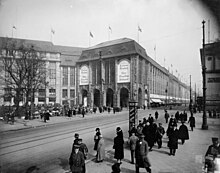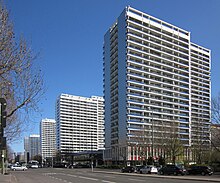Leipziger Straße

Leipziger Straße is a major thoroughfare in the central Mitte district of Berlin, capital of Germany. It runs from Leipziger Platz, an octagonal square adjacent to Potsdamer Platz in the west, to Spittelmarkt in the east. Part of the Bundesstraße 1 highway, it is today one of the city's main east–west road links.
History
Leipziger Straße has existed along this line since about the Baroque Friedrichstadt extension, laid out in 1688 at the behest of Elector Frederick III of Brandenburg. It was named after Leipzig Gate near Spittelmarkt, part of the Berlin Fortress which was finally slighted in 1738. In 1734 the road was extended up to the new Potsdam Gate, present-day Potsdamer Platz, one of the western entrances in what was then the Berlin Customs Wall.
Near the eastern end, Leipziger Straße traversed
Nearby is the intersection with Jerusalemer Straße, named after


At its western end Leipziger Platz was given its current name in 1815 in celebration of the Coalition victory over the French Empire at the Battle of Leipzig, and it is sometimes assumed that Leipziger Straße was named at the same time: in fact it already had this name after the historic trade route to Leipzig. On the corner with Leipziger Straße stood the Wertheim department store, then the biggest in Europe. Demolished in 1955/56 the preserved basement of its ruins housed the Tresor techno nightclub in the 1990s. It is now the site of the Mall of Berlin shopping mall.
The area around the
Between 1933 and 1936 Hermann Göring oversaw the construction of the vast
Today

Large sections of Leipziger Straße were destroyed in World War II. Upon the erection of the Berlin Wall, the east–west connection at Potsdamer Platz was closed. Despite the low traffic volume, the eastern half of the road between Spittelmarkt and Charlottenstraße from 1969 onwards was broadened and rebuilt as a prestigious street of a Socialist capital with four car lanes in each direction, a median and broad pavements including an underpass for pedestrians. On both sides large housing estates of the Komplex Leipziger Straße were erected. Dönhoffplatz was rebuilt as a green area and decorated with the reconstructed 18th century colonnades by Carl von Gontard, installed roughly at the historic site.
The western half of the road retained its historic dimensions and has been newly built-up almost completely since
External links
 Media related to Leipziger Straße (Berlin-Mitte) at Wikimedia Commons
Media related to Leipziger Straße (Berlin-Mitte) at Wikimedia Commons
